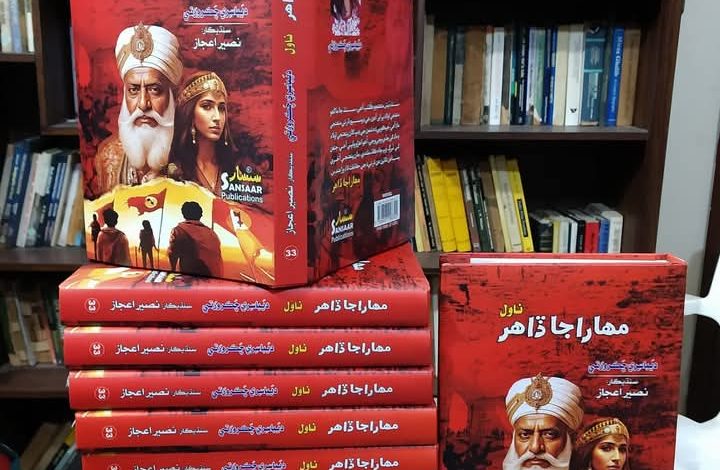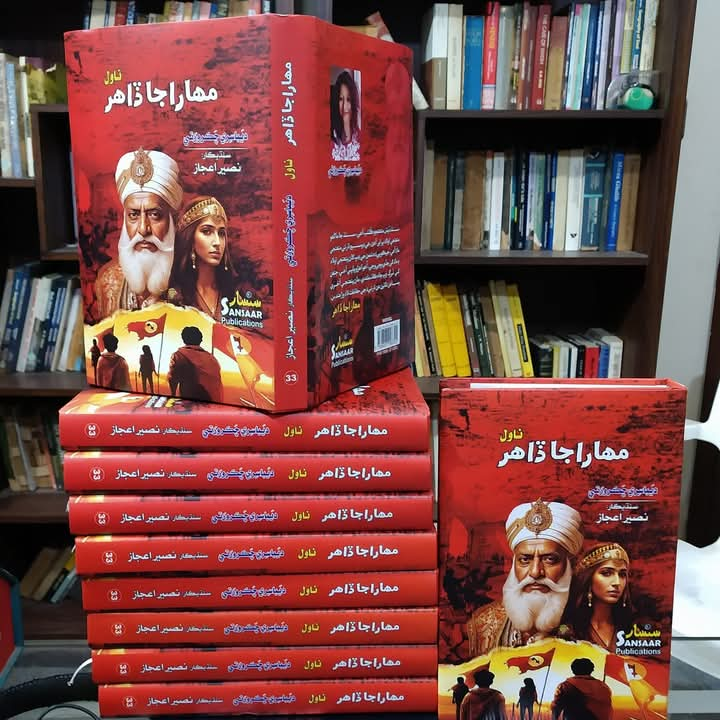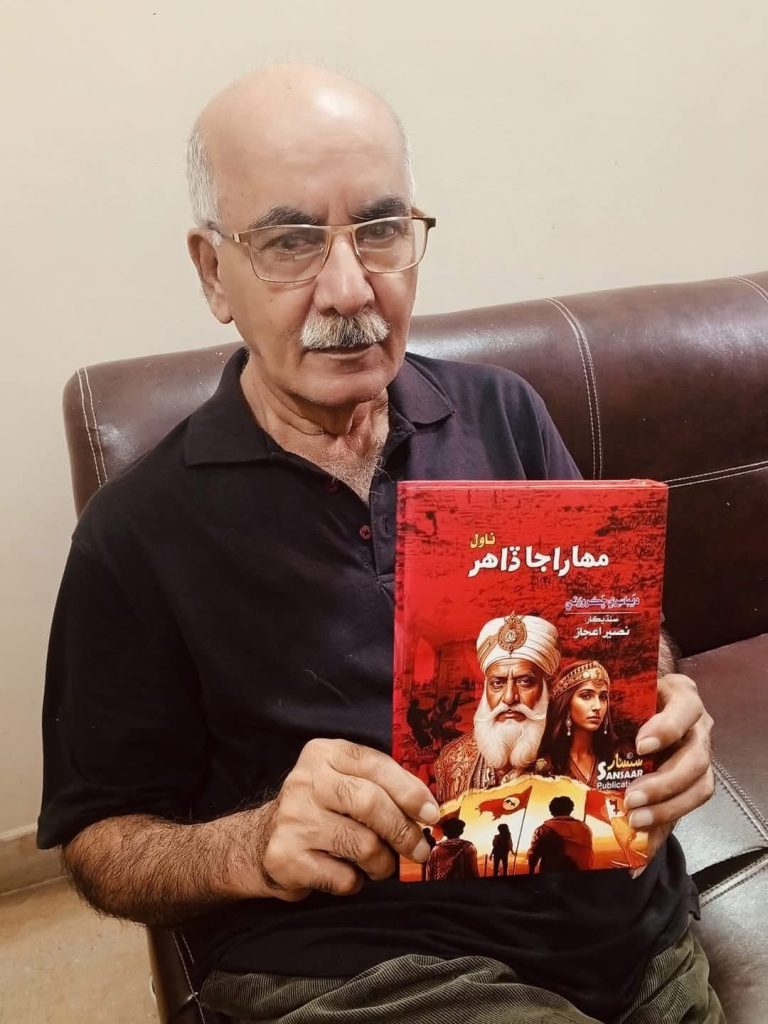The Fall and Modern-Day Exploitation of Sindh
Book Review of Maharaja Dahir by Debasree Chakraborti

 The novel ‘Maharaja Dahir’ by a Kolkata-based novelist Debasree Chakraborti is an ambitious work of historical fiction, blending real events with creative storytelling to highlight three significant periods of history. The novel, originally written in Bengali and later translated into English by Mr. Rajesh Giri of Kolkata and in Sindhi language by a senior journalist and writer Nasir Aijaz of Sindh province of Pakistan, (in the photo holding a copy of the novel, below) explores themes of betrayal, resistance, imperialism, and survival, making it a compelling read for history enthusiasts and lovers of political thrillers alike.
The novel ‘Maharaja Dahir’ by a Kolkata-based novelist Debasree Chakraborti is an ambitious work of historical fiction, blending real events with creative storytelling to highlight three significant periods of history. The novel, originally written in Bengali and later translated into English by Mr. Rajesh Giri of Kolkata and in Sindhi language by a senior journalist and writer Nasir Aijaz of Sindh province of Pakistan, (in the photo holding a copy of the novel, below) explores themes of betrayal, resistance, imperialism, and survival, making it a compelling read for history enthusiasts and lovers of political thrillers alike.
Structure and Themes
The novel unfolds in three distinct yet interconnected phases:
1. The Fall of Sindh (7th–8th Century AD)
2. Espionage in East Pakistan (Bangladesh War, 1971)
3. Modern-Day Exploitation of Sindh
Each phase is woven together through the search for a diary—an artifact linked to Maharaja Dahir’s daughters—creating a bridge between past and present.
Phase One: The Fall of Sindh
The novel opens with a gripping account of the Arab invasions into Sindh during the 7th century, culminating in the conquest of Sindh in 712 AD by Muhammad bin Qasim. Chakraborti’s portrayal of Maharaja Dahir is heroic—he emerges as a valiant ruler who, despite being betrayed by Arab traders and refugees whom he had granted asylum, stands firm in defending his kingdom.
The depiction of the war is both vivid and tragic. The author does not shy away from describing the horrors of the Arab conquest: the destruction of temples, the mass enslavement of Sindhi women, and the ruthless plundering of the region. One of the most emotionally charged moments in the novel is the fate of Maharaja Dahir’s daughters, who were captured and sent to the Arab Khalifa as gifts. In a shocking turn of events, they exact their revenge against Muhammad bin Qasim, leading to their brutal execution.
This phase of the novel resonates deeply with readers, particularly those interested in South Asian history. Chakraborti successfully challenges the dominant historical narrative by presenting an alternative perspective on the Arab conquest—one that emphasizes the resistance of Sindhis rather than merely their defeat.
Phase Two: Espionage in East Pakistan (1971)
The novel shifts from the ancient past to the violent years leading up to the creation of Bangladesh in 1971. Here, the narrative takes a spy-thriller approach, following an Indian agent who infiltrates Pakistan under a false Muslim identity. His mission: to locate a diary that belonged to one of Maharaja Dahir’s daughters, which holds secrets of historical significance.
This section of the novel is particularly engaging, as it provides an inside look into the covert operations of intelligence agencies. The protagonist’s journey highlights the brutalities committed during the Bangladesh Liberation War, linking them thematically to the historical injustices of Sindh’s past. Through the spy’s eyes, readers witness the machinations of war, political intrigue, and the secret battles fought behind the scenes.
Although this part is fictional, it reflects the real-world tensions between India and Pakistan, showcasing how history continues to shape political rivalries. The blending of espionage with historical discovery adds an element of suspense that keeps the reader invested.
Phase Three: Contemporary Exploitation of Sindh
Running parallel to the espionage plot is the modern-day exploitation of Sindh, particularly the oppression of Sindhi Hindus. This section of the novel highlights the socio-political issues of forced conversions, human trafficking, and the unequal distribution of resources between Sindh and Punjab.
The protagonist’s mission takes an unexpected turn when he rescues a Hindu girl who was abducted from Sindh, forcibly converted, and sold in Lahore. She was being trained as a suicide bomber before he intervened. Their relationship evolves into a love story, which adds an emotional depth to the novel. His decision to marry her represents a symbolic triumph over the forces that sought to erase her identity and humanity.
This phase serves as a stark reminder that historical injustices often continue in different forms. Chakraborti draws clear parallels between the Arab invasion and modern-day persecution, suggesting that Sindh’s struggle for justice and autonomy is an ongoing battle.
Writing Style and Impact
Chakraborti’s writing is deeply evocative. She combines historical accuracy with dramatic storytelling, making the reader feel both the grandeur and the tragedy of the events she describes. The descriptions of battlefields, palaces, intelligence meetings, and underground trafficking networks are richly detailed, immersing the reader in each era.
One of the novel’s greatest strengths is its emotional depth. Whether it is the tragic end of Maharaja Dahir’s daughters, the protagonist’s moral dilemmas as a spy, or the suffering of modern-day Sindhi Hindus, the novel evokes a strong response. The author’s ability to weave historical and contemporary narratives together makes this work unique and thought-provoking.

Criticism and Controversy
Given its subject matter, Maharaja Dahir is likely to generate debate. The novel challenges conventional historical narratives, particularly regarding the Arab conquest of Sindh. It presents the Arab forces not as liberators but as brutal invaders, a perspective that may not sit well with all readers.
Additionally, the book’s depiction of Pakistan’s political and social issues—especially those concerning Sindhi Hindus—may be seen as controversial. Some may argue that the novel takes a strong pro-Indian stance, particularly in its portrayal of intelligence agencies. However, from a literary perspective, the novel serves as a counter-narrative that gives voice to those who feel overlooked in mainstream historical discourse.
Conclusion: A Powerful Historical Saga
Maharaja Dahir is more than just a historical novel—it is a deeply political and emotional work that sheds light on the past while making a strong statement about the present. By exploring themes of betrayal, resistance, and survival across three different time periods, Chakraborti delivers a powerful story that stays with the reader long after the last page.
For those interested in South Asian history, political thrillers, or novels that challenge mainstream narratives, Maharaja Dahir is a must-read. It is a rare work that bridges the gap between history and contemporary issues, proving that the past is never truly behind us.






